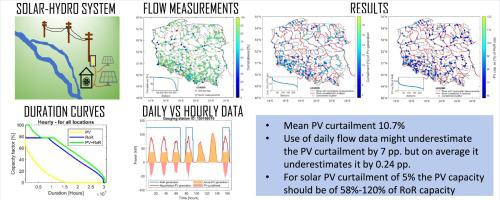当前位置:
X-MOL 学术
›
Energy Convers. Manag.
›
论文详情
Our official English website, www.x-mol.net, welcomes your feedback! (Note: you will need to create a separate account there.)
Solar-hydro cable pooling – Utilizing the untapped potential of existing grid infrastructure
Energy Conversion and Management ( IF 10.4 ) Pub Date : 2024-03-22 , DOI: 10.1016/j.enconman.2024.118307 Jakub Jurasz , Paweł Tomczyk , Bogdan Bochenek , Alban Kuriqi , Egidijus Kasiulis , Diyi Chen , Bo Ming
Energy Conversion and Management ( IF 10.4 ) Pub Date : 2024-03-22 , DOI: 10.1016/j.enconman.2024.118307 Jakub Jurasz , Paweł Tomczyk , Bogdan Bochenek , Alban Kuriqi , Egidijus Kasiulis , Diyi Chen , Bo Ming

|
Over the years, the coupling of various variable renewable energy sources has emerged as a convenient way to partially or fully overcome their highly intermittent nature and low-capacity factors. In literature as well as in practical implementations, the coupling of solar and wind power systems is gaining special attention thanks to their advantageous complementarity in time. However, an area of yet not well-documented potential is the coupling of solar PV plants with non-dispatchable run-of-river hydropower plants. In this study, Poland, which still has significant untapped hydropower potential, is used as a case study. The objective of the work is to quantify the coupling potential with special attention paid to the unavoidable curtailment of solar generation due to the limited grid connection capacity. A simulation model was developed that uses input runoff, irradiation, and temperature hourly data covering the period 01.01.2008–31.12.2022 for 236 selected sites in Poland. Hydrological data were obtained from field measurements, while the remaining meteorological parameters were downloaded from the ERA5 reanalysis database. Hydropower generation was simulated assuming a constant head and a Kaplan turbine operating at different efficiencies depending on the flow rate through the turbine. The available flow was calculated considering environmental flow (e-flows) constraints. The design flow was determined based on the average multi-year flow in the considered river. The complementarity in time of these two renewable energy sources in each location was assessed by considering the grid connection capacity and resulting curtailment in case of too high simultaneous generation from both sources. The analysis showed that the average PV curtailment is about 10.7 % (or 13.2 % when it is solar PV capacity weighted) when the ratio of solar to hydro is equal. Still, it can be as high as 19.7 % in individual cases. To ensure that PV curtailment is no more than arbitrarily (in that case) selected threshold of 5 %, the solar-PV capacity should be between 58 % − 120 % of the designed hydropower plant capacity. The curtailment threshold can be further investigated as an expansion of a techno-economic analysis that fell out of the scope of this work. The additional analysis conducted by means of daily flow data showed a significant underestimation of solar curtailment in individual cases (i.e., up to 7 pp.) and, on average, lower by 0.24 pp. could be expected. Due to interannual flow variations, although the expected mean solar curtailment can be no more than 5 %, there are individual years when it is as low as 2 % and as high as 12 % of this year’s solar generation. The lessons learned from this study shed light on the potential maximization of local power generation through coupling with PV systems and the simultaneous reduction of environmental impacts by releasing higher quantities of e-flows offset by the integration of PV systems.
中文翻译:

太阳能水力电缆汇集——利用现有电网基础设施的未开发潜力
多年来,各种可变可再生能源的耦合已成为部分或完全克服其高度间歇性和低容量因素的便捷方式。在文献和实际实施中,太阳能和风力发电系统的耦合由于它们在时间上的优势互补而受到特别关注。然而,太阳能光伏电站与不可调度的径流水电站的结合,这一潜力尚未得到充分记录。在这项研究中,波兰被用作案例研究,该国仍然拥有巨大的未开发水电潜力。这项工作的目标是量化耦合潜力,特别关注由于电网连接能力有限而不可避免的太阳能发电削减。开发了一个模拟模型,该模型使用涵盖波兰 236 个选定地点 2008 年 1 月 1 日至 2022 年 12 月 31 日期间的输入径流、辐照度和每小时温度数据。水文数据通过现场测量获得,其余气象参数则从ERA5再分析数据库下载。水力发电的模拟假设水头恒定,并且轴流式水轮机根据通过水轮机的流量以不同的效率运行。可用流量的计算考虑了环境流量(e-flow)约束。设计流量是根据所考虑河流的多年平均流量确定的。通过考虑电网连接能力以及两种来源同时发电量过高时导致的限电,评估了每个地点这两种可再生能源的时间互补性。分析表明,当太阳能与水电比例相等时,平均弃光量约为10.7%(如果按太阳能光伏发电容量加权,弃光量为13.2%)。不过,个别情况下该比例可能高达 19.7%。为了确保光伏弃光不超过任意选择的阈值(在这种情况下)5%,太阳能光伏装机容量应在水电站设计容量的58% - 120%之间。可以进一步研究削减阈值作为技术经济分析的扩展,这超出了本工作的范围。通过每日流量数据进行的额外分析显示,个别情况下的太阳能限电被严重低估(即高达 7 个百分点),平均而言,预计会降低 0.24 个百分点。由于年际流量变化,虽然预计平均太阳能弃光率不会超过今年太阳能发电量的5%,但个别年份低至2%,高至12%。从这项研究中汲取的经验教训揭示了通过与光伏系统耦合实现本地发电最大化的潜力,以及通过光伏系统集成所抵消的释放更多电量来同时减少环境影响。
更新日期:2024-03-22
中文翻译:

太阳能水力电缆汇集——利用现有电网基础设施的未开发潜力
多年来,各种可变可再生能源的耦合已成为部分或完全克服其高度间歇性和低容量因素的便捷方式。在文献和实际实施中,太阳能和风力发电系统的耦合由于它们在时间上的优势互补而受到特别关注。然而,太阳能光伏电站与不可调度的径流水电站的结合,这一潜力尚未得到充分记录。在这项研究中,波兰被用作案例研究,该国仍然拥有巨大的未开发水电潜力。这项工作的目标是量化耦合潜力,特别关注由于电网连接能力有限而不可避免的太阳能发电削减。开发了一个模拟模型,该模型使用涵盖波兰 236 个选定地点 2008 年 1 月 1 日至 2022 年 12 月 31 日期间的输入径流、辐照度和每小时温度数据。水文数据通过现场测量获得,其余气象参数则从ERA5再分析数据库下载。水力发电的模拟假设水头恒定,并且轴流式水轮机根据通过水轮机的流量以不同的效率运行。可用流量的计算考虑了环境流量(e-flow)约束。设计流量是根据所考虑河流的多年平均流量确定的。通过考虑电网连接能力以及两种来源同时发电量过高时导致的限电,评估了每个地点这两种可再生能源的时间互补性。分析表明,当太阳能与水电比例相等时,平均弃光量约为10.7%(如果按太阳能光伏发电容量加权,弃光量为13.2%)。不过,个别情况下该比例可能高达 19.7%。为了确保光伏弃光不超过任意选择的阈值(在这种情况下)5%,太阳能光伏装机容量应在水电站设计容量的58% - 120%之间。可以进一步研究削减阈值作为技术经济分析的扩展,这超出了本工作的范围。通过每日流量数据进行的额外分析显示,个别情况下的太阳能限电被严重低估(即高达 7 个百分点),平均而言,预计会降低 0.24 个百分点。由于年际流量变化,虽然预计平均太阳能弃光率不会超过今年太阳能发电量的5%,但个别年份低至2%,高至12%。从这项研究中汲取的经验教训揭示了通过与光伏系统耦合实现本地发电最大化的潜力,以及通过光伏系统集成所抵消的释放更多电量来同时减少环境影响。



























 京公网安备 11010802027423号
京公网安备 11010802027423号